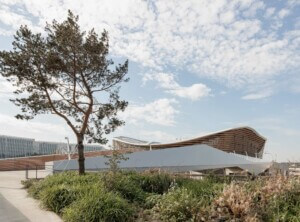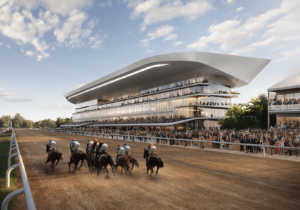This Sunday, all eyes will be on the pitch of the Parc Olympic Lyonnais (Parc OL) for the final match of the 2019 FIFA Women’s World Cup. The United States and its yet-to-be-determined competitor will go head to head in the French town of Lyon for the much-anticipated game, and while most will hope to see soccer star Megan Rapinoe back on the field, the impressive stadium architecture will also be back on full display for one last time.
Designed by Populous and Paris-based firm Naço Architecture in 2016, the low-lying Parc OL, a.k.a Groupama Stadium, is a 578,000-square-foot arena holding nearly 60,000 seats. Its most distinctive feature—a turtle-shaped shell covered in white fabric—shines in the midday sun and is illuminated from within during nighttime play. The four-story concrete, glass, and steel venue actually boasts the nickname “Stade des Lumières” or Stadium of Lights, due to this. In addition, the undulating canopy was designed to mimic the rolling hills and forests found in Lyon, and its support columns look like tree branches, according to Populous principal Gary Reeves in conversation with Interior Design.
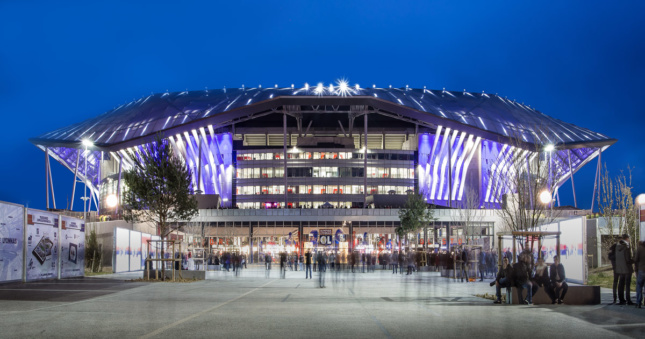
Built just ahead of the 2016 European Championships, the $468 million stadium has quickly become one of the top sporting venues in all of France. It was one of nine stadiums selected to be a part of this summer’s FIFA Women’s World Cup, and as the largest venue on the list by far, it was slated to host nine matches total, including last Monday’s semifinal and the upcoming final.
One of the most compelling reasons so many matches have been scheduled in Lyon is because of the town’s bigtime football history. Several major French professional players have come out of the 500,000-strong city, which sits southeast of the country’s core. Parc OL is also home to the Olympique Lyonnais, the Ligue 1 football club—hence the red- and blue-blocked colors of the bowl. Its women’s team is currently on a 13-year winning streak in the national league, and they’ve won the UEFA Women’s Champion’s League six times since 2011.
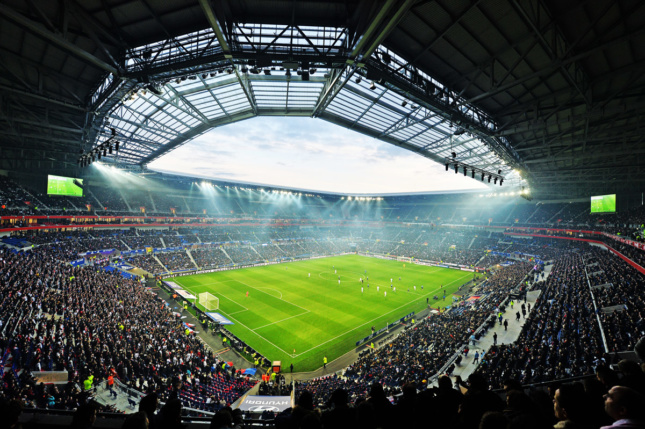
But World Cup-level soccer isn’t the only pro sport the city excels in. Rugby is also huge, as is volleyball, basketball, and ice hockey. In other words, there are plenty of other large-scale sporting venues scattered throughout the city.
While Lyon’s massive sports scene attracts throngs of local and visiting spectators, Parc OL was built outside the heart of the city to the east, away from many other venues. It’s situated next to a commuter highway and is largely surrounded by residential neighborhoods and farmland in the commune of Décines-Charpieu. In order to keep noise from seeping outside the stadium and into the adjacent community during gameplay, Populous designed the space with a large, open bowl that traps the sound of chants going from the north to the south stands. Since Olympique Lyonnais home fans are known to be noisy, the fabric roof also reduces sound reflection.
Other carefully-designed attractions inside Parc OL include a series of lounges on the outer edges of the stadium sectioned off with double-height glazing. Food and beverages areas are also located here. The Salon des Lumières, one the arena’s seven larger dining options, was intentionally designed with a very sleek, French style that fuses the club’s identity in a seamless fashion. Creating subtle nods to the brand on the venue’s interior was important, according to Naço Architecture founder Marcelo Joulia. The design team integrated this, and a handful of other fan-centric elements such as 110 executive suits, multiple meeting rooms, banquet halls, and bars to get more people out to the stadium.
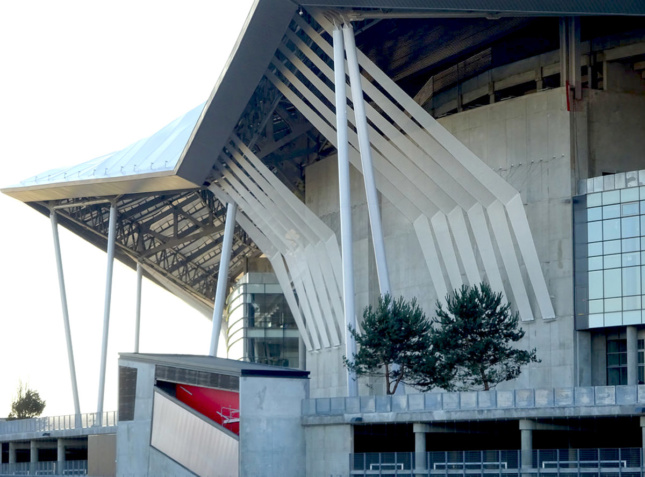
According to Elizabeth Miglierina, an associate architect in Populous’s London office, another driver for interest in the stadium is the fact that the pitch is nearly visible from the podium. She wrote in an interview that the protective roof canopy allows for a more dynamic experience in the communal spaces at Parc OL. The spectator concourses were designed by Miglierina and her team to also allow for varying views of the field and the distant French Alps. Some of those spaces are cathedral-like in feel, with triple-height ceilings and work by global street artists adorning the walls as part of Park OL’s Offside Gallery. The gallery is open even on non-match days.
Like the stadium’s public spaces, the green car park that surrounds the structure also doubles as a place for congregation and play when matches aren’t going on. Populous worked with French group AIA Associés on the durable landscape. For real-time aerial views of the venue, watch the final match of the 2019 FIFA Women’s World Cup this Sunday at 11 a.m. EST.








